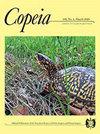麻萨诸塞州科德角亲缘赤豆北侵范围极限的性别依赖耐寒性
IF 2.6
Q2 Agricultural and Biological Sciences
引用次数: 6
摘要
由于耐寒性的限制,许多入侵物种入侵高纬度或高海拔栖息地的能力可能受到限制。然而,在这些物种地理范围边缘的孤立种群可能面临强选择和缺乏不适应基因流的组合,这使得它们能够适应寒冷并进一步入侵。在这里,我们展示了世界上最具入侵性的鱼类之一甘布西亚(Gambusia affinis)(位于美国马萨诸塞州科德角)的一个孤立种群,它可以在比其他种群更低的温度下生存,体型大、寿命长的雌性比雄性表现出更强的耐受性。事实上,雄性的急性耐寒性似乎不足,这表明种群可能主要通过交配雌性推迟后代繁殖到春季的能力来度过冬季。这种雌性耐寒性和生活史的结合可能为这种入侵物种进一步扩展到高纬度淡水栖息地打开了大门。本文章由计算机程序翻译,如有差异,请以英文原文为准。
Sex-Dependent Cold Tolerance at the Northern Invasive Range Limit of Gambusia affinis on Cape Cod, Massachusetts
Many invasive species may be constrained in their ability to invade high latitude or elevation habitats due to limits of cold tolerance. However, isolated populations at the edge of these species' geographic ranges may face a combination of strong selection and lack of maladaptive gene flow that allows them to adapt to the cold and invade further. Here we show that an isolated population of Gambusia affinis (on Cape Cod, MA, USA), one of the most invasive fish in the world, can survive temperatures lower than any reported tolerances for other populations, with large, long-lived females showing more tolerance than males. Indeed, male acute cold tolerance appears insufficient, suggesting the population may persist through winters mainly via the ability of mated females to delay offspring production until spring. This combination of female cold tolerance and life history may open the door for further expansion of this invasive species into high latitude freshwater habitats.
求助全文
通过发布文献求助,成功后即可免费获取论文全文。
去求助
来源期刊

Copeia
生物-动物学
CiteScore
2.10
自引率
0.00%
发文量
0
审稿时长
6-12 weeks
期刊介绍:
Founded in 1913, Copeia is a highly respected international journal dedicated to the publication of high quality, original research papers on the behavior, conservation, ecology, genetics, morphology, evolution, physiology, systematics and taxonomy of extant and extinct fishes, amphibians, and reptiles. Copeia is published electronically and is available through BioOne. Articles are published online first, and print issues appear four times per year. In addition to research articles, Copeia publishes invited review papers, book reviews, and compiles virtual issues on topics of interest drawn from papers previously published in the journal.
 求助内容:
求助内容: 应助结果提醒方式:
应助结果提醒方式:


